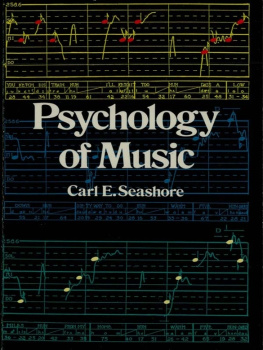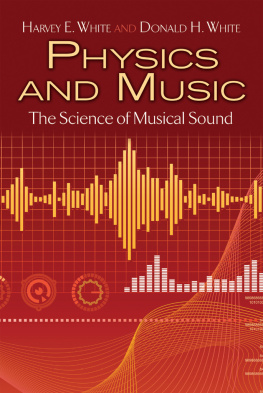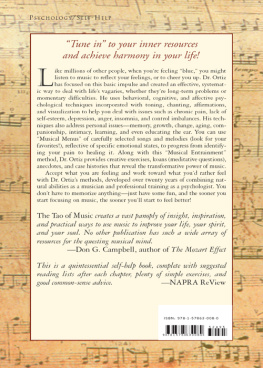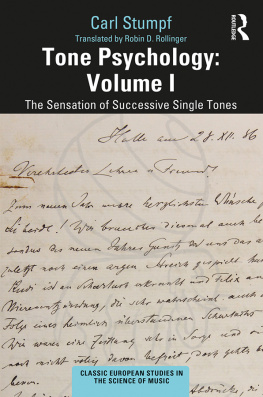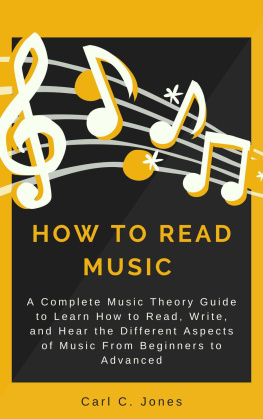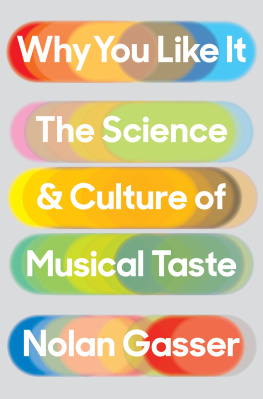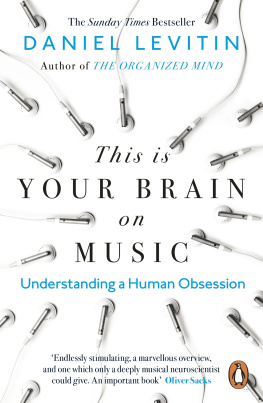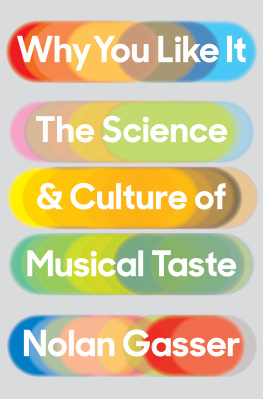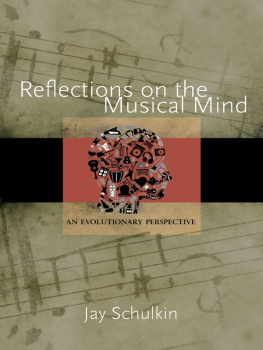Carl E. Seashore - Psychology of Music
Here you can read online Carl E. Seashore - Psychology of Music full text of the book (entire story) in english for free. Download pdf and epub, get meaning, cover and reviews about this ebook. year: 2013;2012, publisher: Dover Publications;Read Books Ltd, genre: Romance novel. Description of the work, (preface) as well as reviews are available. Best literature library LitArk.com created for fans of good reading and offers a wide selection of genres:
Romance novel
Science fiction
Adventure
Detective
Science
History
Home and family
Prose
Art
Politics
Computer
Non-fiction
Religion
Business
Children
Humor
Choose a favorite category and find really read worthwhile books. Enjoy immersion in the world of imagination, feel the emotions of the characters or learn something new for yourself, make an fascinating discovery.
- Book:Psychology of Music
- Author:
- Publisher:Dover Publications;Read Books Ltd
- Genre:
- Year:2013;2012
- Rating:5 / 5
- Favourites:Add to favourites
- Your mark:
- 100
- 1
- 2
- 3
- 4
- 5
Psychology of Music: summary, description and annotation
We offer to read an annotation, description, summary or preface (depends on what the author of the book "Psychology of Music" wrote himself). If you haven't found the necessary information about the book — write in the comments, we will try to find it.
Psychology of Music — read online for free the complete book (whole text) full work
Below is the text of the book, divided by pages. System saving the place of the last page read, allows you to conveniently read the book "Psychology of Music" online for free, without having to search again every time where you left off. Put a bookmark, and you can go to the page where you finished reading at any time.
Font size:
Interval:
Bookmark:

(In the October, 1937, issue of the Music Educators Journal , Professor Mursell has set forth his point of view in regard to methods of evaluating musical talent. As his views are radically different from those presented in this volume, I take the liberty of quoting my reply in the December issue of the same journal in the hope that it may aid in clarifying the important issues involved.)
One attitude toward this problem was expressed in the aggressive and lucid formulation by Professor Mursell in the last issue of this Journal. Accepting the courteous invitation of the editors, I take pleasure in giving my reaction, as one of the spokesmen for the opposite attitude and theory.
His article should be before the reader in considering the validity of the arguments from the two sides on the basis of specific facts. He gives the key to his theory in one sentence.
There is only one satisfactory method of finding out whether the Seashore tests really measure musical ability; and that is to ascertain whether persons rating high or low or medium on these tests also rate high and low and medium in what one may call musical behavior, i.e., sight singing, playing the piano, getting through courses in theory and applied music, and the like.
The idea seems to be this: any test or battery of tests must be validated against behavior and success in all musical situationsmusical behavior, of the types that he mentions, and the like. If this is true, his entire argument can be maintained; if not, the whole argument based thereon falls.
Let me designate his theory as the omnibus theory and mine as the theory of specifics, somewhat on the analogy of the distinction between cure-alls and specifics in drugs. Since his view was stated specifically in part against my six Measures of Musical Talent , now available on phonograph records, I may simplify my argument in the limited space by speaking only of the issue involved in these six measures.
1. They represent the theory of specific measurements insofar as they conform to the two universal scientific sanctions, on the basis of which they were designed; namely, that (1) the factor under consideration must be isolated in order that we may know exactly what it is that we are measuring, and that (2) the conclusion must be limited to the factors under control.
Each of these six tests purports to measure one of six capacities or abilities for the hearing of musical tones. There is little overlapping in these functions, and their isolation for the purpose of measurement has been criticized only in the case of one. In testing, we ask, specifically, How good a sense of pitch, of intensity, of time, of rhythm, of consonance, of immediate tonal memory has this child? The measurements are stated in terms of centile rank and may well be the first and most basic items in a musical profile which may have scores of other factors, quite independent and equally measurable. I deliberately coined the term measure for this type of procedure in order to indicate its scientific character and distinguish it from the ordinary omnibus theory procedure in tests.
2. They have been validated for what they purport to measure. This is an internal validation in terms of success in the isolation of the factor measured and the degree of control of all other factors in the measurement. When we have measured the sense of pitch, that is, pitch discrimination, in the laboratory with high reliability and we know that pitch was isolated from all other factors, no scientist will question but that we have measured pitch. There would be no object in validating against the judgment of even the most competent musician. We would not validate the reading on a thermometer against the judgment of a person sensitive to temperature.
3. They are subject to criticism on the ground of relatively low reliability. But it must be remembered that the phonograph records are a makeshift for the purpose of securing a dragnet group test of an unselected population in a limited period of time and without training for observation. When such requirements are made, we cannot expect high reliability. We should also note that these recordings were designed when we had no precedents to go by for this type of instrument construction and when recording was relatively inferior to what it is today. Careful revision and re-recording is forthcoming.
In actual testing it has been shown that all ratings in the upper half of the group may be counted as reliable for individual diagnosis. Those showing low ratings must always be reinvestigated before any conclusions can be based upon them. The ideal condition is, of course, to use the original measuring instruments of precision. For a responsible experimenter working with laboratory instruments testing a single subject under controlled conditions, the reliability of each of these six measures runs in the high 90s. I would, therefore, admit that the six measures at present are makeshifts but maintain that the principle of measurement for guidance involved is right and highly reliable.
4. They should not be validated in terms of their showing on an omnibus theory or blanket rating against all musical behavior, including such diverse and largely unrelated situations as composition, directing, voice, piano, violin, saxophone, theory, administration, or drums; because there are hundreds of other factors which help to determine job analysis in each of such fields.
In view of this, the ratings found in the formidable table compiled by Professor Mursell are unwarranted. I have been bombarded all these years by the omni-busists for this type of validation, but I have persistently refused action on the ground that it had little or no significance. The two experiments by Brennan in that table which emanated from my laboratory were performed during my years leave of absence under the direction of an outsider inexperienced in testing and against my protests.
For the same reason, I have always protested against the use of an average of these six measures, or any other number of the same kind and have insisted upon the principle of a profile in which each specific measure stands on its own. Again, for the same reason, I have insisted that even the most superficial rating for selection or placement in musical training or adjustment should be based upon a careful case history and a reliable audition with the profile of measurements in hand. That has always been the procedure in the Eastman School. The experimenter works in the attitude of a physician who takes note of blood pressure, heart action, and metabolism.
It is easy to show that we cannot find a good violinist who does not have a good sense of pitch; or a good pianist who does not have a good sense of intensity, which is the sine qua non of touch. But it does not follow that goodness in these capacities alone will make a good artist.
Validation of pitch against the violinists artistic performance in the actual musical situation would require that we correlate the sense of pitch with objective records of musical performance in pitch intonation or ability to hear artistic pitch deviation in the musical situationnot with the countless other merits or demerits that the violinist may exhibit. The same principle applies to any other scientific measure; such as the sense of intensity with artistic touch by the pianist.
5. They play a primarily negative role in musical adjustment. If a child has the urge, the facilities, and the support for a particular type of achievement in music, the purpose of these measures is to see whether or not a given measure indicates any probable impediment. Great musicians may rate low in one or more of these six, and many other equally important capacities. The musical guide must use his head and consider whether high or low record in a specific capacity has any significance in the specific situation before him.
Font size:
Interval:
Bookmark:
Similar books «Psychology of Music»
Look at similar books to Psychology of Music. We have selected literature similar in name and meaning in the hope of providing readers with more options to find new, interesting, not yet read works.
Discussion, reviews of the book Psychology of Music and just readers' own opinions. Leave your comments, write what you think about the work, its meaning or the main characters. Specify what exactly you liked and what you didn't like, and why you think so.

